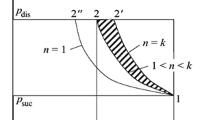Abstract
Wet compression means the injection of water droplets into the compressor of gas turbines. This method decreases the compression work and increases the turbine output by decreasing the compressor exit temperature through the evaporation of water droplets inside the compressor. Researches on wet compression, up to now, have been focused on the thermodynamic analysis of wet compression where the decrease in exit flow temperature and compression work is demonstrated. This paper provides thermodynamic and aerodynamic analysis on wet compression in a centrifugal compressor for a microturbine. The meanline dry compression performance analysis of centrifugal compressor is coupled with the thermodynamic equation of wet compression to get the meanline performance of wet compression. The most influencing parameter in the analysis is the evaporative rate of water droplets. It is found that the impeller exit flow temperature and compression work decreases as the evaporative rate increases. And the exit flow angle decreases as the evaporative rate increases.
Similar content being viewed by others
Abbreviations
- Cgq :
-
Tangential velocity component (m/s)
- Cm :
-
Meridional velocity component (m/s)
- dw/dT:
-
Evaporative rate
- h:
-
Enthalpy
- L:
-
Latent heat
- m:
-
Mass flow rate (kg/s)
- n:
-
Polytropic exponent of dry air compression process
- p:
-
Pressure
- R:
-
Gas constant
- T:
-
Temperature
- U:
-
Blade speed (m/s)
- w:
-
Steam to air ratio
- W:
-
Work
- X:
-
Water/air mass flow ratio
- α:
-
Flow angle (degree)
- γ:
-
Specific heat ratio
- ρ:
-
Density
- 1:
-
Compressor inlet
- 2:
-
Impeller exit
- a:
-
Air
- dry:
-
Dry air condition
- o:
-
Total condition
- vap:
-
Vapor
- w:
-
Water
- wet:
-
Wet condition
References
Bhargava, R. and Meher-Homji, C. B., 2002, “Parametric Analysis of Existing Gas Turbines with Inlet Evaporative and Overspray Fogging,” ASME Paper No. GT-2002-30560.
Bhargava, R., Meher-Homji, C. B., Chaker, M. A., Bianchi, M., Melino, F., Peretto, A. and Ingistov, S., 2005a, “Gas Turbine Fogging Technology : A State-Of-The-Art Review Part I: Inlet Evaporative Fogging — Analytical and Experimental Aspects,” ASME Paper No. GT2005-68336.
Bhargava, R., Meher-Homji, C. B., Chaker, M. A., Bianchi, M., Melino, F., Peretto, A. and Ingistov, S., 2005b, “Gas Turbine Fogging Technology : A State-Of-The-Art Review Part II: Overspray Fogging—Anayytical and Experimental Aspects,” ASME Paper No. GT2005-68337.
Chaker, M. A., 2005, “Key Parameters for the Performance of Impaction-Pin Nozzles Used in Inlet Fogging of Gas Turbine Engines,” ASME Paper No. GT2005-68346.
Chaker, M., Meher-Homji, C. B. and Mee, T. III, 2004a, “Inlet Fogging of Gas Turbine Engines — Part I: Fog Droplet Thermodynamics, Heat Transfer, and Practical Considerations,”ASME Journal of Engineering for Gas Turbines and Power, Vol. 126, pp. 545–558.
Chaker, M., Meher-Homji, C. B. and Mee, T. III, 2004b, “Inlet Fogging of Gas Turbine Engines — Part II: Fog Droplet Sizing Analysis, Nozzle Types, Measurement, and Testing,”ASME Journal of Engineering for Gas Turbines and Power, Vol. 126, pp. 559–570.
Deneve, M., Tandt B. D., Cornelis, N., Bultereys, C. and Gijbels, S., 2005, “Results of the First Application of the SwirlFlashTM Wet Compression System on a 150 MW Heavy-Duty Gas Turbine,” ASME Paper No. GT2005-68726.
Japikse, D., 1996, “Centrifugal Compressor Design and Performance,” Concepts ETI, Inc., USA.
Jeffs, E., 2004, “Get More Power and Less Emissions,” Turbomachinery International, July/ August, pp. 18–19.
Meher-Homji, C. B. and Mee, T. III, 2000a, “Inlet Fogging of Gas Turbine Engines -Part A: Theory, Psychrometrics Fog Generation,” ASME Paper No. 2000-GT-308.
Meher-Homji, C.B. and Mee, T. III, 2000b, “Inlet Fogging of Gas Turbine Engines -Part B: Practical Considerations, Control, And O&M Aspects,” ASME Paper No. 2000-GT-308.
Meher-Homji, C.B. and Mee, T. III, 2005, “Inlet Fogging of Gas Turbine Engines — Part A: Theory, Psychrometrics and Fog Generation,” ASME Paper No. 2000-GT-307.
Savic, S. M., Rostek, K. E. and Klaesson, D. K., 2005, “Techno-Economic Evaluation of Commercially Available High Fogging System,” ASME Paper No. GT2005-68368.
Utamura, M., Kuwahara, T., Murata, H. and Horii, N., 1999, “Effects of Intensive Evaporative Cooling on Performance Characteristics of Land-Based Gas Turbine,”Proceedings of the ASME International Joint Power Generation Conference, New York.
Zheng, Q., Sun, Y., Li, S. and Wang, Y., 2003, “Thermodynamic Analyses of Wet Compression Process in the Compressor of Gas Turbine,”ASME Journal of Turbomachinery, Vol. 125, pp. 489–496.
Author information
Authors and Affiliations
Corresponding author
Rights and permissions
About this article
Cite this article
Kang, JS., Cha, BJ. & Yang, SS. Thermodynamic and aerodynamic meanline analysis of wet compression in a centrifugal compressor. J Mech Sci Technol 20, 1475–1482 (2006). https://doi.org/10.1007/BF02915970
Received:
Revised:
Issue Date:
DOI: https://doi.org/10.1007/BF02915970



